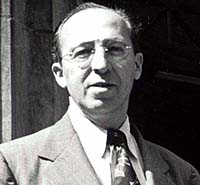The Piano Variations of Aaron Copland may come as a something of a shock to those familiar with Appalachian Spring or Billy the Kid.
Aaron Copland, Piano Variations:
The Piano Variations of American composer Aaron Copland were written for piano solo from January to October 1930. The approximate performance time is 11 minutes.
The Piano Variations were a product of Copland's second-style period, also called the abstract period, which comprised only instrumental (non-vocal) compositions. During this time, the composer moved away from the jazzy idioms he experimented with in the 1920s and started working more in the direction of absolute music. The influence of composition pedagogue Nadia Boulanger, with whom Copland studied in Paris at the Fontainebleau School of Music for Americans, is prevalent in the formal style, logic, patterns, and attention to detail in the Piano Variations and other works in this period.
Copland stated that he worked on the variations individually without an agenda for fitting them together or sequencing them, which seems to contradict the piece's highly ordered construction and seemingly inevitable development. Copland acknowledged this contradiction but maintained that, in fact, "One fine day when the time was right, the order of the variations fell into place." Copland had ambitious plans for this "serious piano piece" — the first of three including the Piano Variations (1930), the Piano Sonata(1939-41), and the Piano Fantasy (1957); he worked painstakingly and thought at epic proportions, saying he "should like to call them like Bach did the Goldberg Variations — but thus far haven't been able to think up a good one."
Unlike a traditional theme and variations, Copland's Piano Variations are not episodic. They are continuously played through, in an undisrupted development of the four-note "row" in the theme from which Copland builds the rest of the piece. All of the content can be traced back to this or transpositions of this four-note motif, suggesting the serialist techniques of Schoenberg. The concision, rigor, and lack of ornamentation have been compared to that of the style of Anton Webern (as in his Variations for piano). The dissonances (ubiquitous minor seconds, major sevenths and ninths) are precisely chosen for their degree of "shock value." While working on the Piano Variations, Copland cultivated a tautness and clarity of form and texture that became a precursor to the style of his other works.
Copland does not actually follow the precepts of the Second Viennese School exactly, although he considers them. Aside from the fact that the four-note "row" is eight tones short of being "12-tone," Copland frequently uses repetition in a declamatory style, as well as modifies and inserts new ideas into his motifs. This is another, smaller-scale form of "variation" that pervades the whole piece. This additional degree of freedom for the composer's imagination permits a gradual metamorphosis of the theme, and in a short period of time he explores many different moods, textures, tonal centers, harmonies, tempi, and rhythms, with a powerful cumulative effect. Copland describes the result as manifesting a "very dry and bare grandiosity."
Copland also experimented with the potential of the physical instrument, as he did with microtones on the stringed instruments in Vitebsk. In the Piano Variations, some notes are held down silently while pitches selected from their overtone series are struck, which produces an effect of ringing resonances without hammering the tones directly.
Another prominent characteristic is the piece's rhythmic irregularity. The meters change constantly within an essentially 4/4 framework.

![Reblog this post [with Zemanta]](http://img.zemanta.com/reblog_e.png?x-id=2bc322da-a591-4031-a8c8-55787119e5b9)







0 comments:
Post a Comment